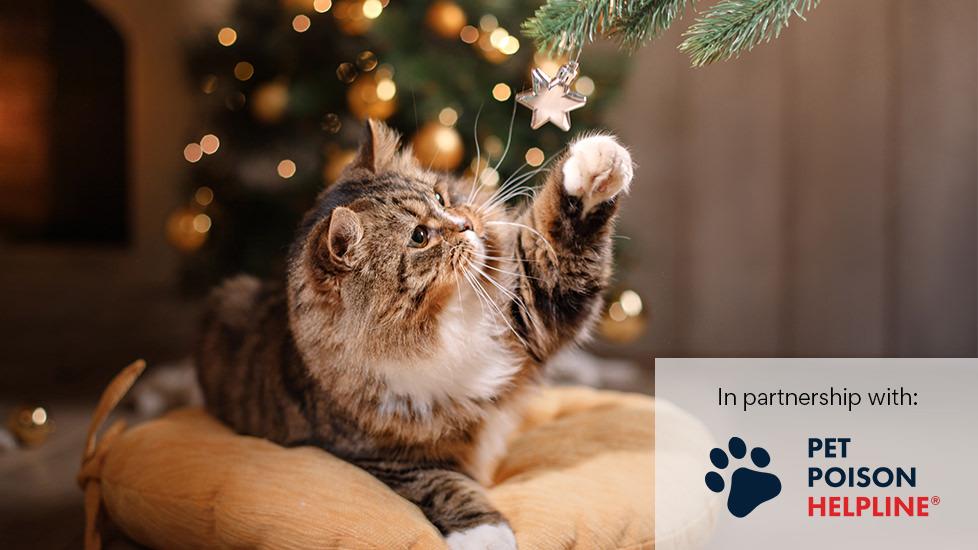6 Most Common Holiday Plants Toxic to Cats
Anna-av/iStock / Getty Images Plus via Getty Images
The most common holiday plants that can be toxic to cats include lilies, Christmas trees, yew, holly, mistletoe, and poinsettias. Some cause mild stomach upset, while others—like lilies and yew—can be life-threatening, so always call your veterinarian or Pet Poison Helpline (855-764-7661) right away if your cat is exposed.
These beautiful living additions to your holiday decorations can be tempting for your cat to investigate. If your cat licks, chews, or eats holiday plants it’s possible that they could become ill, depending on what type they ingest and how much of it.
For this reason, it’s important to consider what plants you bring home around the holidays and what access your cat might have to them.
Key Takeaways
- Common holiday plants that can be toxic to cats include true lilies and daylilies, Christmas trees, yew, holly, mistletoe, and poinsettias.
- Lilies and yew are especially dangerous and can cause life-threatening kidney or heart problems.
- Christmas trees, holly, mistletoe, and poinsettias more often cause gastrointestinal upset, but large ingestions can still be serious.
- If your cat ingests or chews on any holiday plant, call your veterinarian or Pet Poison Helpline (855-764-7661) immediately.
Holiday Plants Poisonous to Cats
Lilies
When we think about lilies and their toxicity in cats, we are usually thinking about true lilies (Lilium sp.), which include Oriental, Asiatic, Easter, and roselily. While not part of the true lily group, Hemerocallis sp., or daylilies, also have similar concerns if ingested by cats.
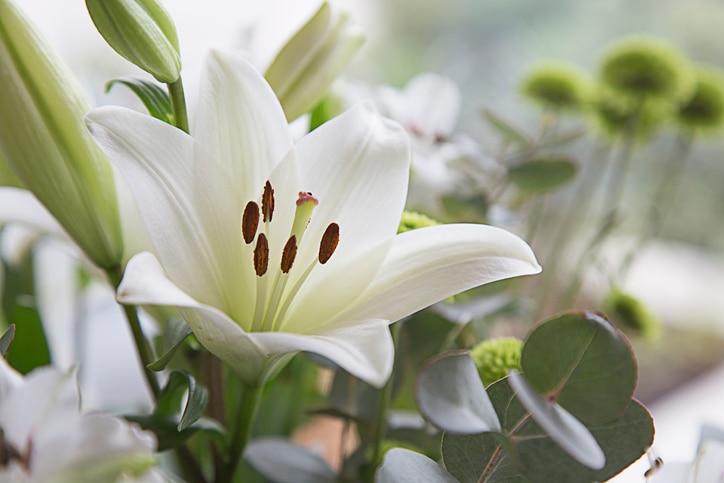
True lilies are a group of plants that make beautiful holiday decorations, both potted and in fresh-cut bouquets. Don’t be confused with other plants that also have lily in the name, such as Peruvian lily, calla lily, peace lily, and lily of the valley. These plants can cause unique concerns of their own and should also be avoided.
Unfortunately, Lilium sp. and Hemerocallis sp. lilies can cause damage to the kidneys in cats, leading to kidney failure and even death if treatment is not started immediately. Exposure leading to kidney injury can occur if any part of the plant is eaten, if water from the vase is consumed, or if pollen is licked from the cat’s fur after contact with the flowers.
If a cat ingests any part of a lily plant, including its pollen or water, contact an emergency veterinarian or Pet Poison Helpline® at 855-764-7661 immediately.
Christmas Tree
Christmas trees come in many varieties including pine, fir, spruce, and artificial. While the needles of live trees are only considered mildly toxic to cats, if your cat eats the needles from a live or artificial tree—it can still cause health concerns.
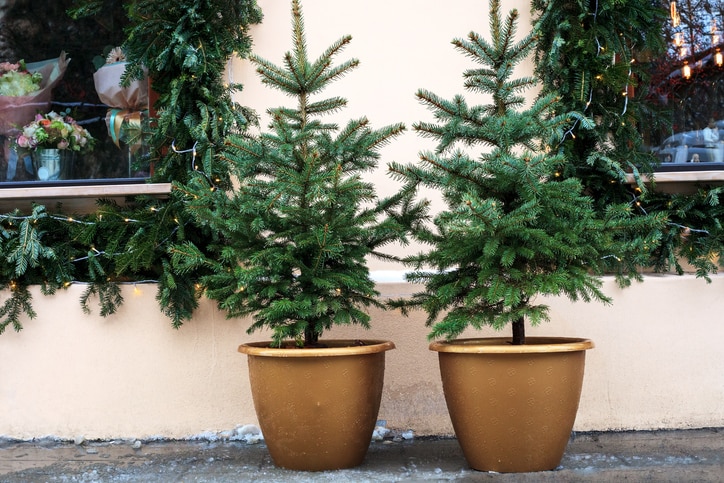
The oils of live tree needles can irritate the gastrointestinal tract and can cause stomach upset, leading to vomiting and a decreased appetite. The needles themselves, from both live and artificial trees, can also irritate the gastrointestinal tract due to their shape and lack of flexibility.
Unfortunately, this means that if your cat eats enough live or artificial tree needles, it may cause vomiting, diarrhea, decreased appetite, or even an intestinal blockage.
Depending on the severity of their symptoms, treatment at a veterinary clinic may be necessary to get your cat feeling well again. Contact your veterinarian or Pet Poison Helpline to determine next steps.
Yew
Yews are evergreen plants that can grow beautiful red berries in the fall and winter months. During the holidays they can serve as an outdoor decoration, a potted indoor plant, a table centerpiece, or a garland.
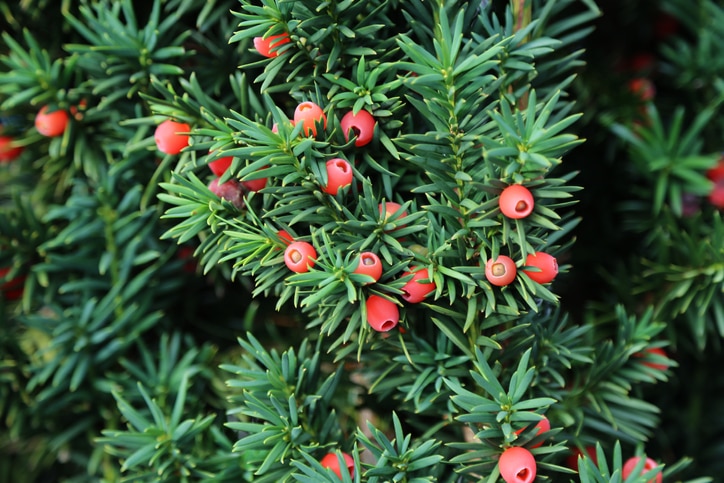
Unfortunately, if a cat ingests yews, it can cause significant poisoning if they eat any part of the plant other than the red flesh (outer layer or skin) of the berry.
Signs of poisoning can include vomiting, diarrhea, difficulty walking, seizures, or an abnormal heart rate. If your cat ingests any part of a yew plant, including chewing on branches, contact your emergency veterinarian or Pet Poison Helpline for next steps.
Holly
Holly can be found in many holiday decorations, from wreaths to garlands to potted arrangements. It is particularly known for its red berries that contrast with shiny dark green leaves. The holly leaves are waxy and prickly so your cat may not be interested in eating them to begin with—which is ideal.

If they do ingest a few leaves or berries from the plant, your cat may develop mild vomiting or diarrhea. If they eat a lot of the plant and berries, they may develop severe vomiting or diarrhea, loss of appetite, or difficulty walking.
If your cat becomes ill from eating holly, contact your emergency veterinarian or Pet Poison Helpline for next steps on what to do.
At the Pet Poison Helpline, you will be connected with trained veterinary toxicology professionals who can help you determine if you need to be concerned about your cat’s exposure to the plant and next steps to take.
Mistletoe
If you are looking for a holiday kiss or just a beautiful greenery decoration, mistletoe may be included in your holiday decor. Though this plant does grow berries, it’s often displayed in the home either without berries or with artificial berries.
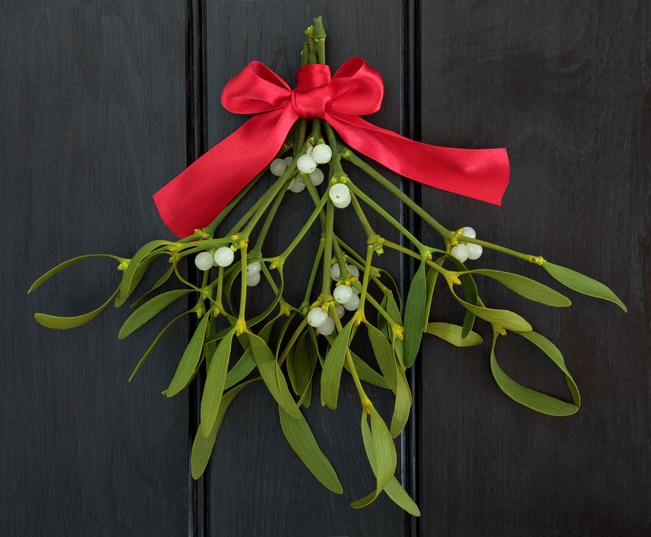
There are two main types of mistletoe—American and European. Fortunately, the American mistletoe that is most commonly found in the U.S. is less of a concern if your cat takes a few nibbles. If you are unsure what type of mistletoe you have, look at the product label before purchasing or reach out to a florist.
If your cat eats any part of the mistletoe plant, they may develop symptoms including vomiting, diarrhea, or a decreased appetite. If you are unsure what type of mistletoe you have, look at the product label before purchasing or reach out to a florist.
However, if more than a few nibbles of mistletoe is ingested, or if any amount of the European variety is ingested, abnormal heart rate or abnormal blood pressure may occur.
It’s recommended that if your cat eats more than just a taste or nibble of mistletoe, or if you suspect a large amount may have been ingested, contact your veterinarian for an exam. This way your vet can ensure the cat’s heart rate and blood pressure are normal and can prescribe any medications to resolve gastrointestinal upset if needed.
Poinsettias
Poinsettias are considered a classic holiday plant. They are commonly displayed potted but can also adorn wreathes, garlands, and Christmas trees. The lush green leaves and flowers may cause gastrointestinal issues such as vomiting if ingested by your cat.
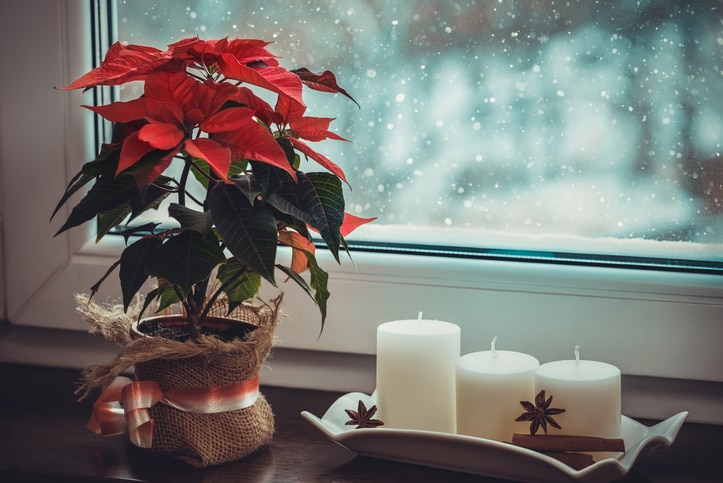
The upset may be mild enough to not require a veterinary visit, but some cats can develop on-going vomiting and need veterinary care. Contact your veterinarian if your cat experiences persistent vomiting after ingesting any part of a poinsettia.
What To Do If Your Cat Ingests a Toxic Holiday Plant
If your feline family member ingests a potentially toxic holiday plant, move the plant somewhere your cat can no longer access, but do not throw it away, because you may need to identify it.
If there is any residue such as pollen or sap on your cat’s fur, gently clean it off with a damp washcloth or pet wipe to avoid your cat ingesting the pollen if they try to groom themselves.
You can contact the Pet Poison Helpline at 855-764-7661, where you will be connected with trained veterinary toxicology professionals who can help determine if you need to be concerned about your cat’s exposure to the plant and if so, next steps. You can also reach out to Chewy’s Connect with a Vet to chat live with a vet about what to do.
They will assess the exposure and determine if your pet needs medical attention or if monitoring at home is sufficient.
If you are certain of the plant your cat was exposed to, be sure to offer this information during the call. This will help guide the vets to provide the best next steps.
If you notice your cat is having severe signs, such as acting less responsive, having difficulty breathing, or having a seizure—seek immediate emergency veterinary care.
Recognizing potential concerns with common holiday plants can help keep your furry family member safe this holiday season. If you are worried your cat may have ingested a plant, it’s better to be safe and recommended to seek guidance right away.
